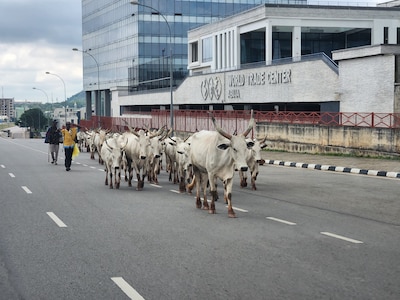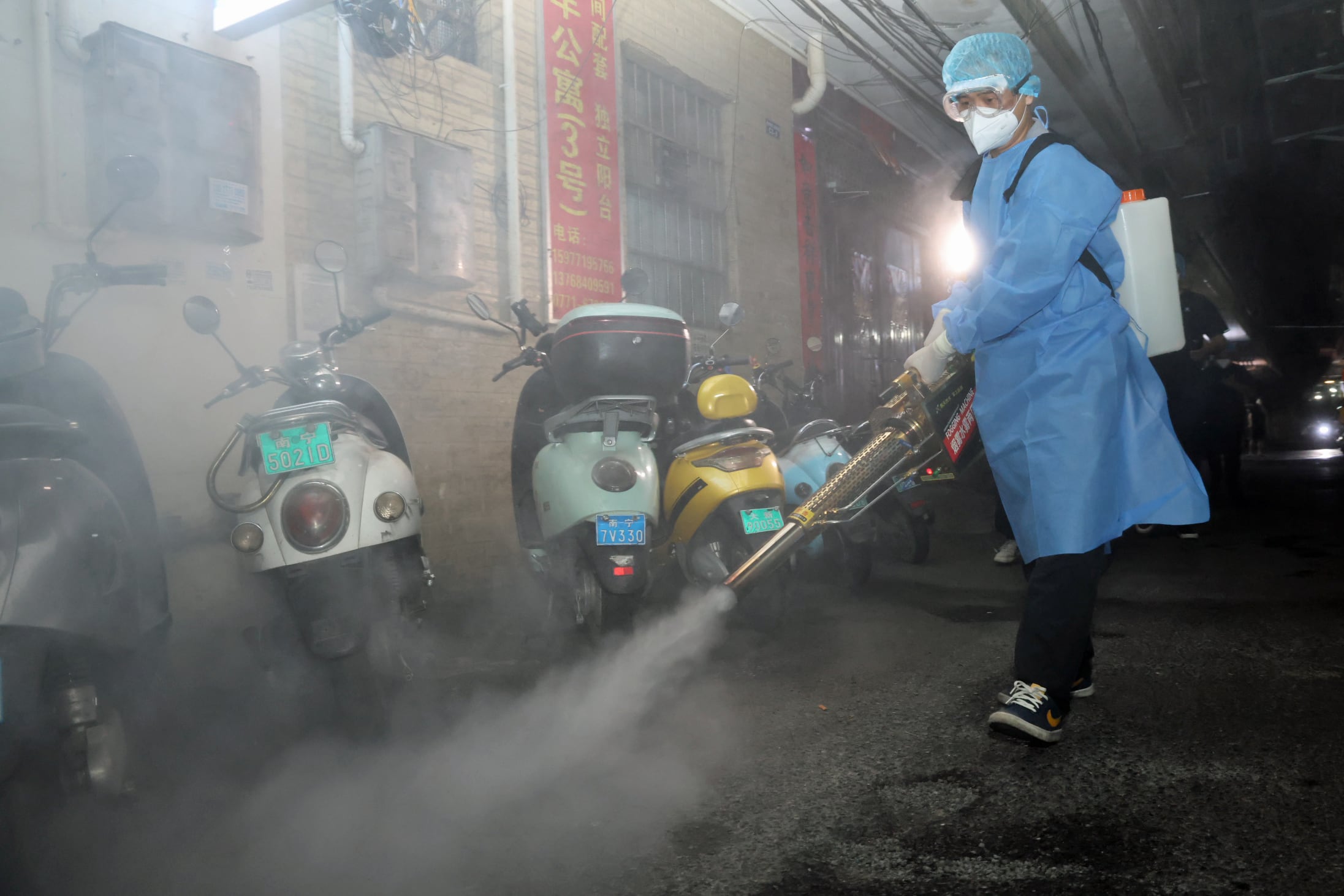Public health, explained: Sign up to receive Healthbeat’s Global Checkup in your inbox a day early.
Hello from Lagos.
I’m in Nigeria this week for a conference with a British development project I’m working with. It’s my first time here, and I can confirm that the food is fiery, the traffic is legendary, and people dress to impress. Even more exciting: Lagos is to Afrobeat music what Nashville is to country music (the warm, pulsating heart), so I’m hoping to hear some live before I fly out.

My name is William Herkewitz, and I’m a journalist based in Nairobi, Kenya. This is the Global Health Checkup, where I highlight five of the week’s most important stories on outbreaks, medicine, science, and survival from around the world.
With that, as we say in Swahili: karibu katika habari — welcome to the news.
Chikungunya: from the tropics to Times Square
This week a team of epidemiologists mapped the growing reach of chikungunya virus in the science journal BMJ Global Health, which now threatens up to 35 million people worldwide, The Times of India reports.
- Disease breakdown: Chikungunya is a virus first identified in Tanzania in the 1950s and is spread by mosquitoes. Its name means “that which bends up,” a nod to the symptomatic contortions caused by terrible joint pain and fever. Although there’s no cure, death is rare, with fewer than 1 in 1,000 perishing from the illness. The real cost is in long-term pain: chronic arthritis that can last for months or years.
If you’ve never heard of this disease, that’s likely because most cases of chikungunya remain in India, Brazil, and Indonesia. But the virus is increasingly spreading beyond the tropics. China is now seeing its worst outbreak on record, while Italy and France are fighting surges of their own. And last week, a Long Island woman tested positive despite not having traveled abroad. If confirmed, that would be the first local transmission in New York.
What’s going on here? I spoke with Dr. Marietjie Venter, an animal-borne virus researcher at the University of the Witwatersrand, in South Africa. We talked about why chikungunya is spreading, and what this means.
She said the main issue at play is that mosquitoes are moving. The Asian tiger mosquito (Aedes albopictus) and the yellow fever mosquito (Aedes aegypti) are the main carriers of the disease. Both have expanded their range dramatically, surviving in places once thought too cold. This comes as humans unwittingly ferry mosquito species across continents and (uh, wittingly) warm the global climate.
“At this stage, chikungunya is really about long-term management rather than eradication,” Venter said. “Once Aedes aegypti or Aedes albopictus mosquitoes establish themselves in an area warm enough for them to survive the winter, it becomes extremely difficult to eliminate them.”
Venter also says that unless we stop warming the planet, today’s situation shouldn’t be seen as a high-water mark for chikungunya, but the new normal. And just as outbreaks are spreading through southern Italy and France, the same could soon happen across the southern United States, where both invasive mosquito species have taken hold. “It’s not something to panic about, but it is something to be aware of,” she said.
Malaria’s comeback in Cameroon
Reuters has a report this week on the death of a 9-month-old boy in northern Cameroon. He’s one of a growing number of malaria fatalities that local officials and aid workers are directly linking to the U.S. pullback in foreign assistance. The story is heartbreaking but straightforward:
“Before the cuts, Mohamat might have been diagnosed earlier by one of more than 2,000 U.S.-funded community health workers who would travel over rough dirt roads to reach the region’s remotest villages … [but] nearly all of the U.S.-funded community health workers are now out of service.”
The core issue is that the Trump administration has cut funding for America’s malaria-fighting program, the President’s Malaria Initiative, by nearly half from recent levels of about $800 million a year. This program once paid the stipends and supplied the drugs for the community health workers reaching families like Mohamat’s. In the story, officials warn that northern Cameroon’s malaria fatality rate may have already erased a decade of progress. It’s worth noting that although U.S. funding cuts triggered this crisis, Cameroon’s government (which earns billions from oil and other exports, but ranks as one of the most corrupt in the world) has failed to step up and provide these basic medical services.
As I wrote two weeks ago, the U.S. government insists its new “America First” health strategy will still reduce malaria cases and deaths, but it doesn’t say how. Ultimately strategies, goals, and promises mean little if the math doesn’t work. For perspective, from 2010 to 2023, the United States contributed roughly 37% of all global malaria funding, according to the World Health Organization. Halving that support while promising the same outcome — without explaining how — seems like magical thinking.
Something’s in the air
We tend to think of air pollution risk in terms of lung damage, like asthma or lung cancer. But The Guardian reports that a new global review of studies across 11 countries has found a strong link between long-term exposure to polluted air and an increased risk of “frailty” in middle and older age. The researchers define “frailty” as a clinical state marked by reduced strength, slowness, and a lower ability to recover from illness.
Context: The type of study here matters a lot. Health reporting has long struggled with how to cover single studies, which can sometimes overstate results or show false findings. That’s not necessarily because of fraud or bad science, but simply because when thousands of studies are run, a few will produce statistical outliers that look exciting by chance alone. It’s how you end up with whiplash headlines: “Coffee/chocolate/wine linked to cancer,” and “Coffee/chocolate/wine shown to prevent cancer.” You know the ones I mean.
But this isn’t a single study. This new review is a “meta-analysis,” meaning it’s a synthesis of data from dozens of studies. That gives it more statistical weight and helps pin down patterns that would be impossible to prove on a case-by-case basis, but hold up across different populations.
What’s the takeaway? The correlation was relevant for developing and richer countries alike, even wealthy countries like the UK. “Since frailty can be reversible,” one independent researcher notes, reducing pollution now isn’t just about preventing disease, it’s about preserving quality of life, “extend[ing] years of independence, and eas[ing] the strain on health and social services,” for millions globally.
Growing drug-resistant infections in newborns
Australian researchers are sounding the alarm on a disturbing rise in drug-resistant infections in newborns across South and Southeast Asia, Newsweek reports. In many cases, standard antibiotics fail, leaving doctors scrambling to treat babies with dwindling options. The story highlights hospitals in India, Bangladesh, and Nepal where “neonatal sepsis” (essentially blood poisoning) is caused by resistant bacteria.
The report links several drivers: overuse of broad-spectrum antibiotics (some given even in advance of any illness), weak infection control in hospitals, and a lack of diagnostic labs to guide medication decisions. In one hospital, a newborn unit saw a strain of bacteria (Klebsiella pneumoniae) resistant to a class of last-resort antibiotics. These infections quickly escalate in fragile newborns whose immune systems barely exist.
What’s the takeaway? “Antibiotic resistance spreads across borders,” one researcher warned. While chikungunya or malaria might never touch most readers directly, drug-resistant infections are increasingly likely to. Once resistance takes hold, there’s no rewinding it, and slowing it down will require serious global cooperation and accountability. Moving forward also means another kind of investment, the researchers say. “With so few new drug candidates in the pipeline, we need a significant investment in antibiotic development.”
Finally, some good elephant news
It’s welcome (if not a bit Dr. Seussian) news this week: Scientists in the UK have trailed the first vaccine in elephants, the BBC reports. The vaccine protects the animals from a deadly virus, called elephant endotheliotropic herpesvirus. The illness is reportedly the largest disease risk for Asian elephants, enough so that “seven baby elephants have died of it over the last decade,” at the Chester Zoo in the UK, where the drug trials took place on six individuals.
Last year, a Houston Zoo elephant received an experimental version of a similar vaccine, which is based on the mRNA vaccine advancements that led to the Covid vaccines. But this marks the first proper trial. (Now, you can almost hear the voiceover: “Ask your zookeeper if Tuskaris is right for you.”)
In all seriousness, this is a rare piece of hopeful science, and not just for a species under siege. Just as mRNA vaccines this decade pushed the boundaries of how quickly we can design and test human vaccines, this work shows how far those advances are spreading — to new tools and new species. It’s also a small but meaningful step toward using modern medicine to help endangered animals fight their own battles to survive.
William Herkewitz is a reporter covering global public health for Healthbeat. He is based in Nairobi. Contact William at wherkewitz@healthbeat.org.







